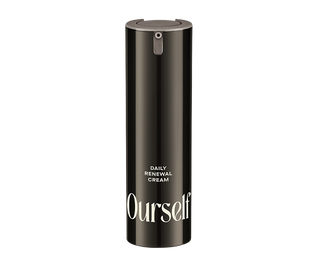Melasma 101

Everything you need to know about the causes of melasma, how to treat, and most importantly, how to prevent this condition in the first place.
Often referred to as “the mask of pregnancy,” melasma is one of the most stubborn forms of hyperpigmentation. And while hormonal changes can certainly be a common trigger, the condition is not limited to pregnant women. Like all forms of hyperpigmentation, it’s caused by an overproduction of melanin, but unlike smaller dark spots, it’s typically characterized by broader patches, often on the forehead or cheeks, giving it that mask-like description.
We asked board certified dermatolgists and Ourself medical advisors Dr. Diane Orlinsky and Dr. Eva Simmons-O’Brien A.K.A. The Lady Derm Docs to break down the most difficult type of hyperpigmentation to treat: melasma.
What is melasma?
According to The Lady Derm Docs, melasma is one of the three types of hyperpigmentation characterized by brown patches that are typically larger than say, a dark spot or discoloration caused by post-inflammatory hyperpigmentation (PIH).
What causes melasma?
While the exact causes are unknown, we do know that the condition is related to sun exposure and/or hormonal changes linked to factors such as birth control and pregnancy.
“Melasma disproportionately affects women, and especially women of color,” Dr. Simmons-O’Brien points out.
How do you treat melasma?
“With melasma, it’s not a one-and-done, but we do prefer to work with chemical peels and microneedling,” says Dr. Simmons-O’Brien.
Adds Dr. Orlinksy: “We do not recommend lasers at all.”
They also stress the importance of pre-treatment: “We have our melasma patients do a two week regimen of Daily Dark Spot Intercept, Daily Renewal Cream, and Mineral Sunscreen Broad Spectrum SPF 50 before treatment and the results are spectacular.”
How do you prevent melasma?
Both dermatologists agree that sunscreen is the number one method of prevention.
“But don’t forget: You have to use a whole shotglass full and reapply often whether you are inside or outside,” says Dr. Simmons-O’Brien.
They also recommend ancillary protection like UV-treated visors and supplements like Heliocare.
How do patients maintain results?
Dr. Simmons-O’Brien stresses there is no quick fix for melasma, and “you have to actively maintain and prevent melasma, for life.”
To help prevent this stubborn hyperpigmentation issue, use Daily Dark Spot Intercept twice a day to halt dark spots at their source. Brightening Intides™ improve radiance for a more even-toned complexion, providing cumulative results as you use it.
The Lady Derm Docs have tested and highly recommend The Ourself Everyday Regimen, which includes Daily Dark Spot Intercept to halt pigmentation at its source, Daily Renewal Cream to nourish and protect the skin’s barrier, and Mineral Sunscreen SPF 50 to protect from both UV and blue light damage. Stick with this regimen daily to get the best results.

